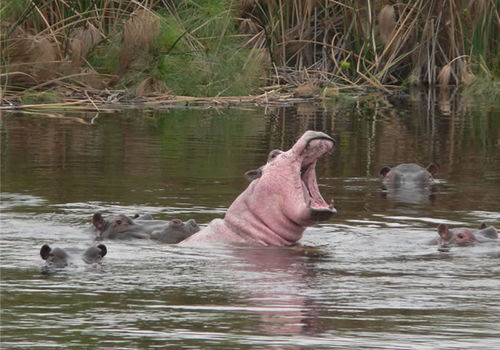
Hippo
Hippopotamus amphibiusHippo
Introduction: The origin of the name hippopotamus (Hippopotamus amphibius) comes from the Greek 'water or river horse'. This comes as no surprise as they are strong and fast swimmers and will attack when wounded or agitated. They are characterized by their huge mass; short, barrel-shaped body, smooth naked skin and short, stout legs.
The hippo is the most dangerous animal in Africa and is responsible for more human fatalities and injuries in the wild than any other mammal. They are usually found in schools / pods / bloats of 5 to 20, but often congregate in larger numbers. Adult bulls will aggressively defend their territory and most males have scars from previous conflicts. Small boats and in some cases mokoros, have been overturned or badly damaged as a result of hippo attacks. They are in the main protecting their young, but your poler on a mokoro trip on the Chobe or Zambezi Rivers will steer clear of hippo, especially if they are with their families.
Distribution: As Namibia is predominantly a desert country, hippo are uncommon and can only be found in the rivers of the extreme north-east of the country in the Kavango and Caprivi regions.
Diet: Hippo are grazers and forage for grass on the river bank at night. Buffalo and couch grasses are a particular favourite. A full feed is about 130kg of green grass, but not all of this is digested in one day. Some remains in the stomach for the next night's binge.
Colouring: The body is a greyish-black with a pink tinge.
Breeding: Cows give birth to a single young in shallow waters in dense reedbeds which has a mass of around 30kg. Gestation periods average 240 days. Calves are born in the water and can swim before walking.
Size: Hippos can weigh up to 2,500kg and stand about 1.5m at the shoulder. They have a head and body length of up to 3.7m. The females are lighter and smaller and calves lighter coloured than adults.
Klein Windhoek

